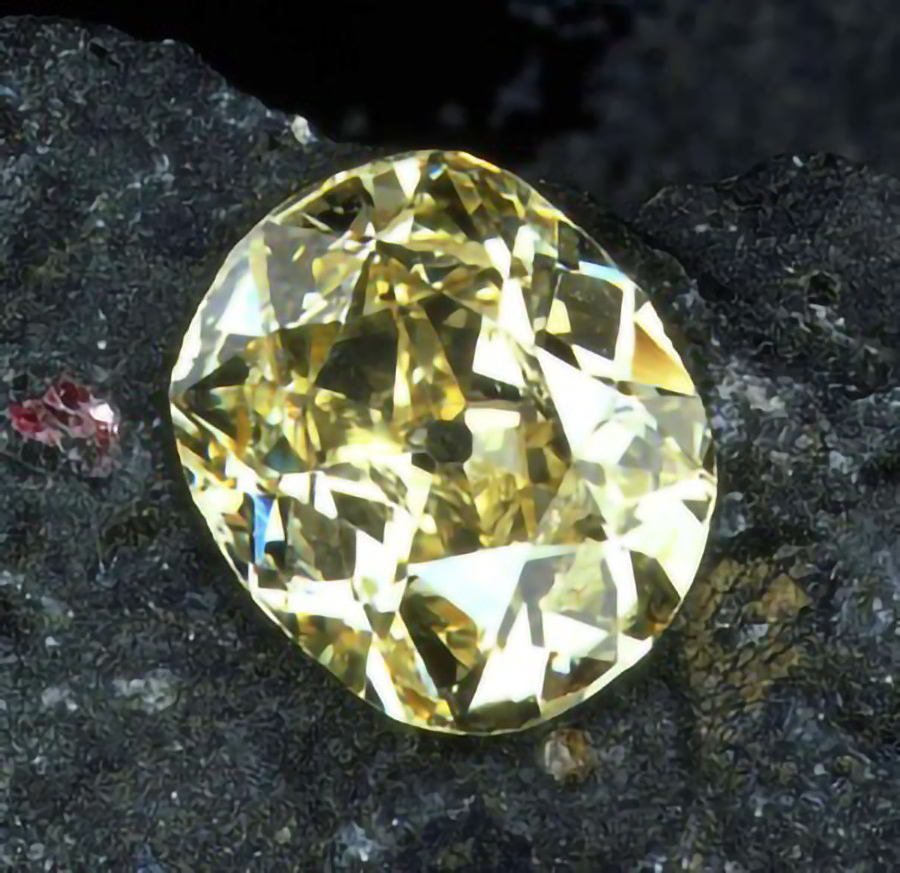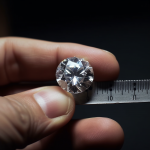Diamond Prices
Read moreThe Eureka Diamond
The Diamond That Changed The History Of South Africa Forever
The Eureka Diamond is not very impressive by gemstone standards yet, it has earned its place among the greatest diamonds in history. A mere 21 carats in its rough form, a brownish-yellow color; it is unlike other legendary diamonds that have inspired adoration almost instantly. It was the first diamond ever discovered in South Africa, and its discovery changed the world’s perspective on the country itself. The Eureka started the Diamond Rush and the Mineral Revolution which changed the face of South Africa. Without the interest prompted by the Eureka, the unearthing of many great diamonds such as the Kimberley would have never happened! Most diamonds move through history over time but the Eureka created history.
If you’d like to learn more about the Eureka Diamond, in this article you will find:

- Discovered in
- 1876
- Country of Origin
- South Africa
- Mine of Origin
- Near Hopetown, on the bank of the Orange River
- Carat Weight
- Initially 21 carats, cut down to 10.73 carats
- Cut Shape
- Cushion-shaped brilliant
- Clarity
- not available
- Color
- Brownish-yellow
- Previous Owners
- Erasmus Stephanus Jacobs (initial recipient)
- Schalk Van Niekerk (neighbor and collector)
- John O’Reilly (traveling salesman)
- Sir Philip Wodehouse (buyer)
- Marquess of Bute
- Lord Colum (son of Marquess of Bute)
- Christie’s (London auction)
- Anonymous buyer
- De Beers (acquired in 1967)
- Current Owner
- Mine Museum in Kimberley, South Africa
- Estimated Value
- Not provided.
The Origins of the Eureka Diamond
The Eureka Diamond was unearthed in South Africa in 1876. As with most famous gems that have a long history, there are conflicting stories about their origin. The most popular stories differ in how did the man who ultimately began the stone’s circulation in the market acquire the stone. It is known that the stone was initially found by children, but the circumstances remain a mystery.
The Eureka Diamond is gifted as a neighborly gesture.
The first legend about the Eureka diamond says that it was found by a shepherd boy who was working close to Hopetown, on the bank of the Orange River. The youth thought it was just a shiny pebble and gave it to his friend, 15-year-old Erasmus Stephanus Jacobs. Erasmus, unaware of its value, reportedly went on to play jacks with the camouflaged pebble!
Erasmus Jacobs was neighbors with a man by the name of Schalk Van Niekerk who was an appreciator and collector of interesting minerals. The boy gifted the shiny pebble to the man for his collection. It happens that a traveling salesman, John O’Reilly, was passing by and became interested in this particular marble. He wanted to buy it off Van Niekerk. However, the latter insisted that the stone was worthless and refused to take O’Reilly’s money.
Schalk Van Niekerk’s Daughter Discovers the Eureka Diamond
The second version legend is that the stone was found by Van Niekerk’s daughter while playing in the yard with a bunch of pebbles of different kinds. The sun was setting while a traveling salesman, John O’Reilly, was passing by their house. He saw one of the pebbles reflect the sunlight beautifully and uniquely. O’Reilly thought that there must be something special about this stone. This is where the historical aspect comes into play and the legends merge. There is no doubt that O’Reilly offers to buy the stone but Van Niekerk does not want to take his money.
Schalk Van Niekerk and John O’Reilly Examine the pebble
John O’Reilly was an honest man and he shared the reason behind his wish to purchase the stone with Van Niekerk. He suspected the stone was precious. At this point, neither of the two men thought that this could be a real diamond although they thought that maybe there could be some value to it. The diamond was sent for examination and the agreement entailed that if it did turn out to be precious, they could split the profit. O’Reilly took the stone to Coleberg where he met with the acting Civil Commissioner Lorenzo Boyes. Boyes believed the stone to be a diamond as he tried cutting glass with it and was successful.
The Commissioner knew a man by the name of Dr. W. J. Atherstone, who was an authority on minerals and gems. Atherstone lived in Grahamstown in the Cape Colony. The traveling salesman sent the Eureka to the doctor in an unmarked envelope. Dr. Atherstrone confirmed the stone to be a real diamond. He put the weight of the diamond as 21.25 carats. Some scholars now believe that the stone was 24.00 carats but this has not been confirmed.
The Cutting of the Eureka Diamond
The diamond was eventually sold to Sir Philip Wodehouse who returned to the United Kingdom in 1870 and subsequently had all of his diamonds cut and sold. This would have included the Eureka Diamond as well. It weighed 21.25 carats and it was cut down to 10.73 carats. It was cut into a cushion shape that complemented its brownish-yellow color.
The Recent Ownership History of the Eureka Diamond
After the stone was initially found and confirmed to be a genuine diamond, a buyer was found in the face of Sir Philip Wodehouse who purchased the Eureka Diamond. This was after the diamond had been displayed at the Paris Exhibition. The price of the gemstone was set to £500. Since the exhibition took place in 1867, Sir Wodehouse would have bought the Eureka somewhere around this time. After 1870, he had all his diamonds cut and sold.
The Eureka Diamond returns to South Africa
Towards the end of the 19th century, the Marquess of Bute bought the diamond. The stone was bought as a present for his wife who had just given birth to their first son and heir. She outlived her husband and their youngest son Lord Colum remained living with his mother. Lord Colum received the Eureka Diamond as a present from her. He put it up for sale at Christie’s in London in 1946. The jewel sold for £5,700 to an anonymous buyer. De Beers bought the diamond back in 1967 and presented it to the people of South Africa.
The Technical Characteristics of the Eureka Diamond
The Eureka Diamond is a cushion-shaped brilliant that weighs 10.73 carats in its cut form. A clarity grade for it is not available. The diamond is a brownish-yellow color. This would make the Eureka a Type IaAB diamond – most probably. Not much information is available about the technical characteristics of the gemstone.
The Significance of the Eureka Diamond
The Eureka Diamond is an extremely important milestone for South Africa. Its discovery marked a before and after for the world diamond trade. Mid-19th century the country was a very distant and poor part of the world. The land was used mainly for livestock and their biggest export was wool. The Eureka Diamond unearthing brought a lot of interest to South Africa and it changed the country’s position in the world. The Eureka also served as a beacon of hope for many of the locals who now could see a path for themselves that could bring them to a better life.
Furthermore, the discovery of the Eureka Diamond was an important milestone for the diamond industry as well. At the time (and even today) the trade is fully dependent on fruitful mines that can produce a lot of gemstones. The industry had run into diamond fields drying up before, creating a crisis. The Eureka provided a completely unexplored place that helped stabilize the Diamond Market and continues to play a key role in it even today.
The Eureka Diamond receives its name
South Africa was uncharted territory for the diamond industry. The Eureka diamond received its name because it was the first gemstone discovered in the country. Much like the instant that led to Archimedes’ epiphany, bringing on the famous catchphrase; the unearthing of the precious stone was a mind-blowing achievement. Its finding started the Diamond Rush, sometimes referred to as the Kimberley Diamond Rush.
The Eureka Diamond marks the start of the Diamond Rush
The Diamond Rush meant there was a massive migration wave toward South Africa. Workers from around the continent and the rest of the world rushed to this new and exciting opportunity. The country turned out to be a ‘golden’ mine for diamonds. The rush was responsible for the founding of the Kimberley Mine and eventually – the city of Kimberley. The new changes, however, came at a cost. A lot of trial and error was used to determine what the best ways to mine diamonds in this area would be. Underground mines were the best choice and companies like De Beers poured a ton of resources into them.
The Eureka Diamond marks the start of the Mineral Revolution
The discovery of the Eureka Diamond is also used to mark the beginning of the Mineral Revolution. It drove the development and urbanization of South Africa. It pulled the country out of its previous static rate and wool export. However, the diamond industry treated the workers at the bottom of the food chain very badly. Even though a luxurious item was being produced, the ones responsible for mining it was not rewarded very highly. This drove a rift in the politics of the country as well. Some believe this may be one of the reasons that led to segregation in South Africa.
The Eureka Diamond is gifted to South Africa
De Beers was one of the crucial stakeholders that drove and benefitted from the Diamond Rush in South Africa. In recognition of the country’s vital role in their establishment as a global diamond conglomerate, they decided to give back the Eureka as a modest, but symbolic gift to the people of South Africa. The Eureka Diamond is currently held at the Mine Museum in Kimberley, South Africa.
The diamond was briefly displayed at the Musée de Minéralogie in Paris, which is a part of the Muséum national d’Histoire Naturelle (the French National Museum of Natural History), in 2001. The diamond was loaned to the museum for a temporary exhibition called “Diamonds” that was held from October 17, 2001, to March 31, 2002. The exhibition showcased some of the world’s most famous diamonds, including the Eureka Diamond, the Koh-i-Noor, and the Cullinan. After the exhibition, the Eureka Diamond was returned to the Mine Museum in Kimberley, South Africa.
We hope you enjoyed the read!
If you’d like to read about other famous diamonds like the Orlov, Premier Rose, or Koh-i-Noor diamonds, you can visit Ajediam’s Journals. Or, if you’re feeling inspired, you can browse Ajediam’s premium diamond collections shop.



